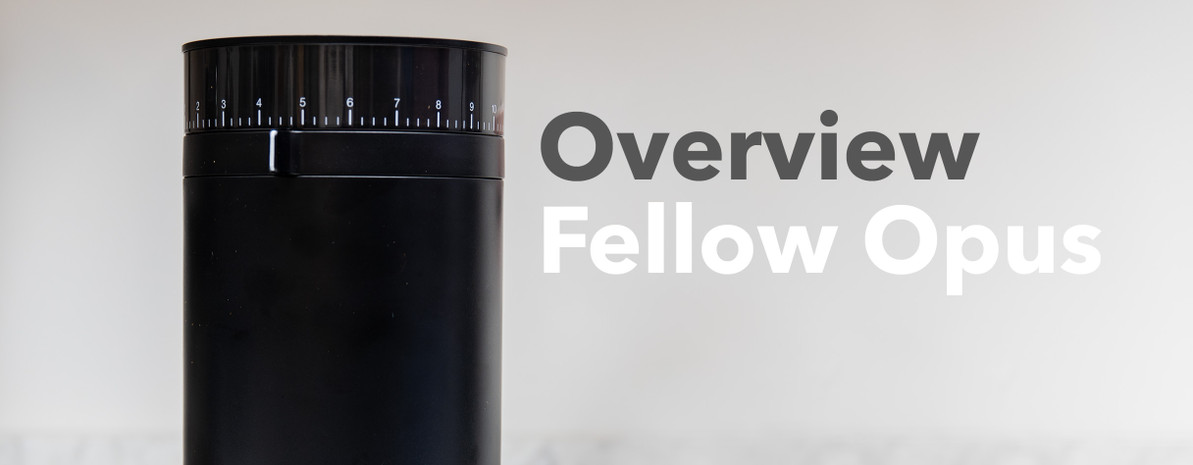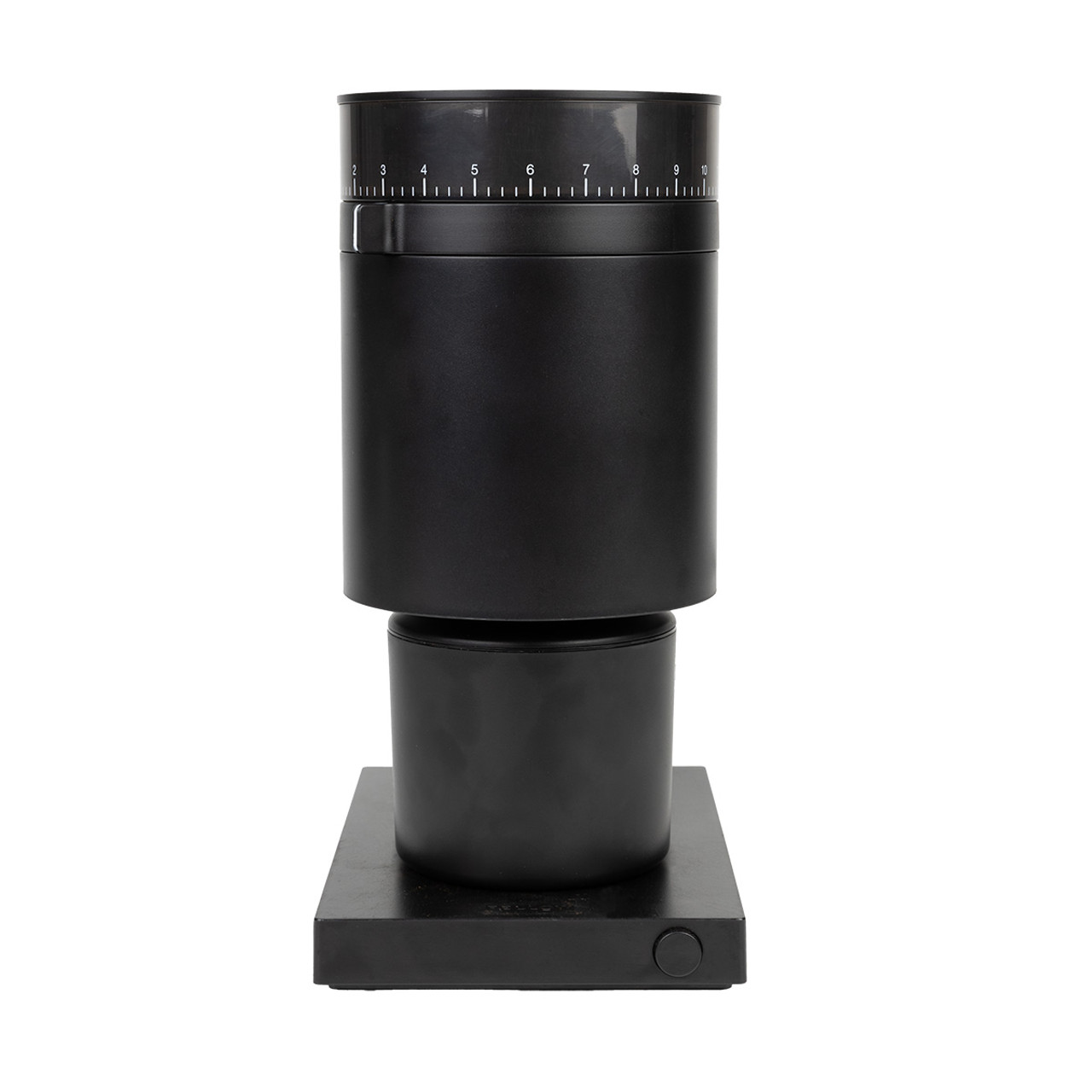Video Overview | Fellow Opus
The Fellow Opus is Fellow's new multi-purpose grinder that offers up exceptional grind quality from espresso to cold brew! It boasts the same chic and geometric design that has become a staple of Fellow's equipment, both macro and micro adjustments, anti-static technology and much more all for a modest price point under $200. The Opus has changed the game by offering multi-purpose, electric grinding at a whole new price point.
Hey there. It's Ragan from Prima Coffee, and this is the Fellow Opus Multipurpose Grinder. The Opus is a game changer, offering multipurpose electric grinding for under $200 while boasting the same beautiful and geometric design that we've come to love from Fellow.
There's a lot going on in this grinder, both internally and externally. So let's take a closer look. Externally, you'll see that the Opus comes in the same chic matte black that you get with the Ode. It stands at 26.8 centimeters tall, 12.9 centimeters wide and 21 centimeters deep. And the entire body, including the hopper and grounds, catch are made from plastic. So you lack the sturdy feel you find in the Ode but that contributes to the modest price point. However, like the Ode the Opus has a magnetic grounds catch that slides right under the chute. And because it works as an espresso grinder, it comes with a convenient single dosing cup that slides right into the ground's catch. And it's compatible with 54 to 58 millimeters portafilters which make it incredibly simple to transfer your coffee grounds to your portafilter. It has a time start button on the bottom front of the grinder to work out. You'll do one quick, press two, grind for 30 seconds, two quick presses for 60 seconds of grinding, three quick presses for 90 seconds and press and hold for 2 minutes of continuous grinding. It's also designed with single dosing in mind, but has a hopper capacity of 110 grams and a hopper lid that doubles as a container that can sit on a scale and help you weigh out your beans. The lid also has recommended grind settings.
The Opus is equipped with 41 macro adjustments on the outer ring and 12 additional micro adjustments on the inner ring. I'll explain more about that in a minute. When we dial in for espresso and pour over internally, it's outfitted with C6-40 Burly Burrs that are: six blade 40 millimeter conical burst. Fellow has made it where removing the outer burr is incredibly simple. All you have to do is lift the handle, twist and pul. This feature makes grinder maintenance super simple. The vertical design of the Opus is meant to reduce grind retention. However, in our tests we found that it does have pretty significant retention between point five and one gram with each dose. It also has anti-static technology meant to reduce mess, which makes it way more enjoyable to use. It also is a relatively quiet grinder compared to other options. Lastly, it has a high powered motor with six Newton meters of torque and 350 rpms leaving you with beautifully uniform grinds.
The Opus is unique because it offers a full grind range from true nine bar espresso to cold brew while maintaining style, a small footprint and an incredibly modest price point, making espresso more accessible to coffee enthusiasts. It's also backed by a two year warranty, three If you register it through Fellow, it's a fantastic grinder for those looking for an electric multipurpose grinder on a budget without skimping on results. It's ideal if you aren't worried about extreme precision and are fine with a stepped adjustment.
So let's take a closer look at the Opus. I'm going to walk you through dialing in for both espresso and pour over and talk more about how the micro adjustment works. Let's begin with espresso, because this is the application where the micro step comes into play on the outer ring. Each of these tick marks equates to 50 microns. But if you pop this off and direct your attention to this little blue dial, you'll see that the notch is lined up with the center line. This is how the grinder comes straight out of the box and is supposed to be calibrated to start grinding for espresso immediately. However, you will see that there are there's a plus sign which indicates courser and six tick marks and a minus sign indicating finer and six tick marks. This concept took me a while to grasp, but once I got my hands on the grinder and was able to test it myself, it clicked. So I will try to make this as simple as I can. Each of these little micro steps equates to 33 microns. So if we were trying to dial in espresso and wanted to go slightly finer, we would move the mark two ticks to the right finer and then we would return the outer ring and move it a macro step, courser. This will make a change of 16 microns and it's easier to show than explain.
So I have the grinder set at two steps on the macro adjustment and we are going to pull a shot without using the micro adjustment. We're going to grind 18 grams. Okay. Pop the dosing cup in and grind. We’ll pop this out, and this is the cute little dosing cup you can line up a portafilter, and flip it over. Super simple. Let's see, that shot actually came in at a pretty good time. If we wanted it to run a little faster or a little slower, we can go in and change our micro adjustment and this will change our shot by about 2 to 3 seconds. Okay, So I'm going to go two steps, micro steps coarser, and that will equate to 66 microns. To counteract that, we are going to actually go a macro step finer to now make it a change of 16 microns.
Dialing in for pour over is way more simple and doesn't require the precision you need with espresso. So I would say that the 50 micron difference with the macro steps is adequate. So at a setting six with a medium fine grind, my brew ended at around three and a half minutes, which was what I was going for. So let's give it a try. It definitely produced a really balanced cup of coffee. You get a nice sweetness. I think a lot of that has to do with the particle uniformity, and I would say that the Opus is a commendable brew grinder.
Although the price point of this grinder is impressive. There were some tradeoffs to get it there. First and foremost, it's difficult. The micro adjustment definitely presents a learning curve and is necessary when dialing in for espresso. Secondly, the step adjustment limits the precision you get when you're dialing in. And lastly, the plastic body feels cheap, but that's just an aesthetic observation and doesn't affect the grind quality.
So this is the fellow Opus. It's an affordable electric multi-purpose grinder that produces some really impressive results for the price point. It boasts a modern aesthetic and is a phenomenal option. You can find it online at primacoffee.com and thanks for watching.




